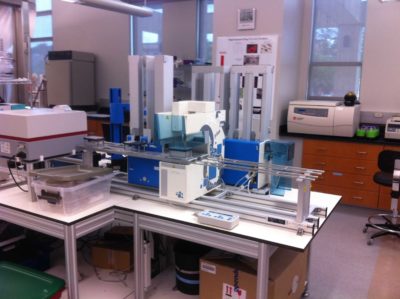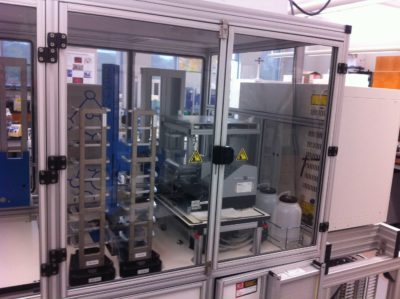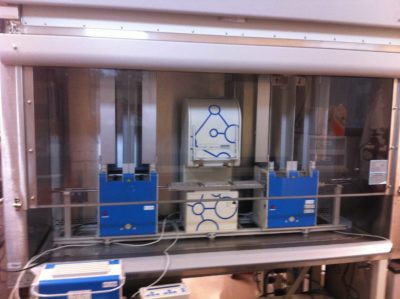Texas A&M University (TAMU) High Throughput Screening (HTS) Drug Screening Lab
Robotics for adding compounds from a library to cells or other samples in 96 or 384 well plates:
The HTS-Lab located on the first floor of ILSB provides several automated liquid-handling robots for conducting biochemical and phenotypic whole cell assays, allowing us to test 100 to tens of thousands of samples at a time. These robots can also be utilized for high-throughput sample prep of DNA and RNA samples for Next-Gen sequencing.
Plate readers and robotic microscope to measure compounds or image cells in the wells of multi-well plates
Several plate readers in the lab offer the capability to read absorbance, fluorescence and luminescence signal based assays as a single end point measurements as well as following the assay kinetics over time.
A GE IN Cell Analyzer 2000 microscope allows us to incorporate high-throughput, high-content imaging into assays that can observe changes at the single cell and subcellular levels. Coupled with the image analysis software, it is possible to perform assays involving cell or organelle morphology, subcellular localization and/or heterogeneous cell populations
Compound libraries:
To support HTS efforts, the team uses several compound libraries in enzyme- or cell-based assays which include a 1000-compound fragment library, libraries containing FDA-approved drugs, a ~104,000 compound diversity library, and a ~160,000 sample natural products library. Our custom in-house diversity library is unique as it is designed to offer chemically diverse compounds with drug-like properties. We have enough (~5mgs) of each of the 100K chemicals to do about 1000 screens. The robotic systems provide the advantage of not only screening compounds at one concentration but also allow the user to prepare and test serial dilutions of compounds. This enables the user a way to tailor their screen and further characterize compound hits with dose response data.
Another advantage of our HTS platforms is compound annotation for activity. This means each time a new target is screened; the pharmacological “dossier” of each compound in the screening library becomes annotated in our database. For example, if you were to get an active compound that kills a parasite, you could check the database and immediately know if it also kills human cells or other organisms. Currently, we have compounds that have been tested for activity against bacterial pathogens, such as Mycobacterium tuberculosis; parasitic pathogens of humans and farm animals, such as malaria and cryptosporidium; and human cancer cell lines, such as lymphoma and ovarian cancer.
Connecting to another drug-screening facility:
The HTS lab can also help investigators develop assays that can be used at the TAMU Institute of Biosciences and Technology in Houston to do drug screening, especially image-based assays (see https://ibt.tamu.edu/about/contact.html)



